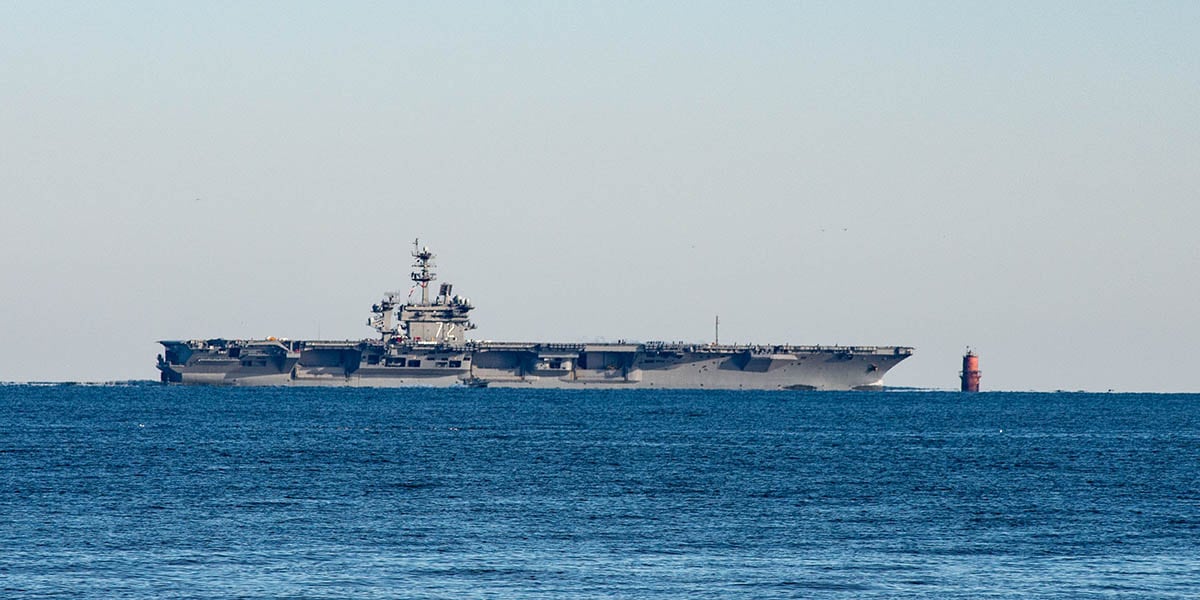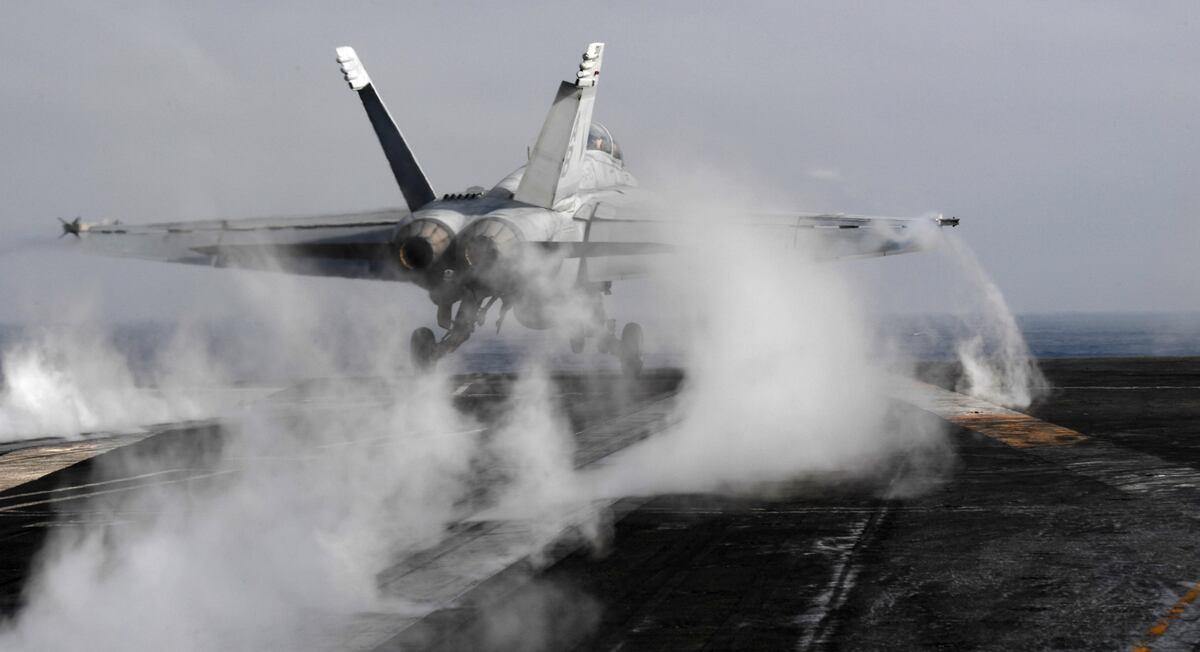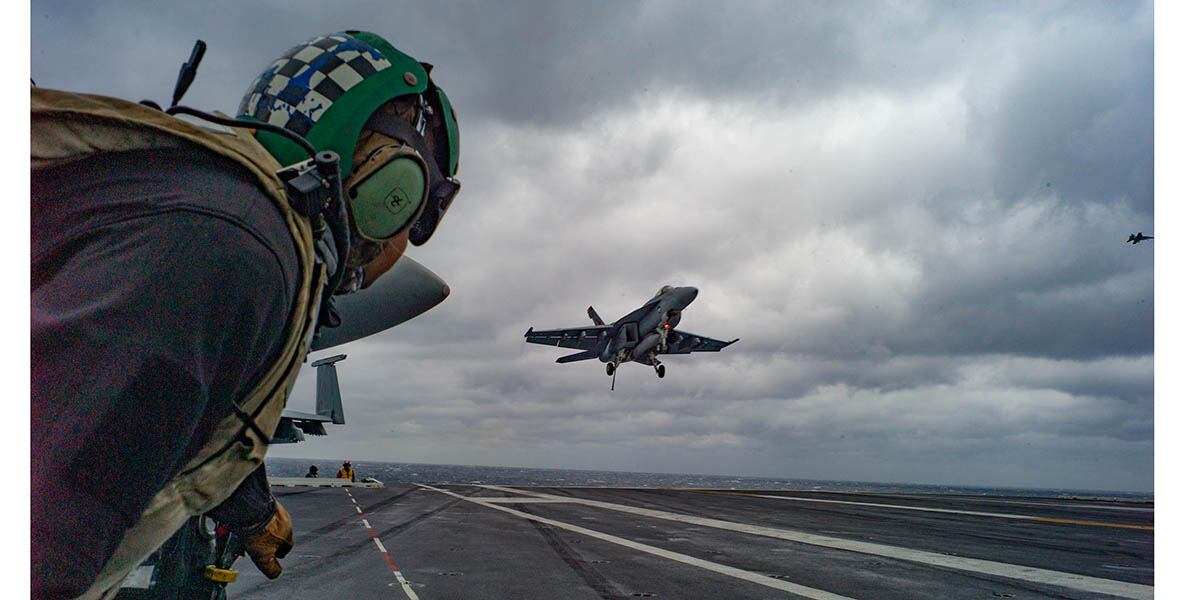ON BOARD THE SUPERCARRIER ABRAHAM LINCOLN — There’s a carrier strike group fighting a war off the coast of Virginia, but nothing’s exploding.
The Abraham Lincoln is in the midst of its Composite Unit Training Exercise — or COMPTUEX — the flattop’s final war game evaluation before departing Norfolk and heading east on a global deployment that will take the carrier to its new homeport in California.
“The whole purpose of this exercise is to bring the whole strike group together to conduct operations,” said Rear Adm. John Wade, commander of Carrier Strike Group 12. “Using a sports metaphor, [we are] doing sets and reps, blocking and tackling of increasing complexity so we have both the confidence and competence to carry out or mission.”
The COMPTUEX kicked off on Friday, with the Abraham Lincoln transitioning from the drumbeat of routine carrier qualifications to the cyclic efforts needed to sustain combat at sea.
“Days are long. They are really long. In fact, the day never ends on an aircraft carrier,” said Capt. Putnam H. Browne, the skipper of the Abraham Lincoln.
Browne pointed to the carrier’s catapult crews and their frenetic “fly day.”
“Right now we’re doing about a 12-hour fly days and they have a couple hours on either end to prepare the catapults and to shut them down,” he said. "So now you are talking about 16 hours, plus any maintenance that has to be done.”
For the carrier’s leadership team, they’re not just juggling flight deck operations but also the Navy’s new guidelines designed to ensure sailors get the proper amount of rest to function, part of a series of reforms that have swept the service in the aftermath of twin guided-missile destroyer collisions in the Western Pacific in 2017.
“In some cases, they get very little sleep,” Browne said. “We have to ensure good sleep and good rest for all the crew, so we are trying to come to an ability to operate and manage everyone’s crew rest, too.”

This is the second East Coast carrier strike group to use high-tech training the Navy calls “LVC” — live, virtual and constructive — for its COMPTUEX.
Instead of pitting the carrier strike group against a flotilla of Navy warships playing the role of the enemy, trainers rely on computer-based adversaries to test the air wing and the warships, prepping them to “be ready for anything that could pop up on deployment,” Browne said.
“It allows you to simulate an asset from another country and fight that asset. Sometimes you can do it as an overlay for a ship or aircraft asset that is there or you can simulate it and you have to defend yourself.”
Navy leaders remain mum on the exact scenarios they throw at carrier strike groups, but the idea is adapt them to deploy like the Harry S. Truman Carrier Strike Group did last year when it mastered the Pentagon’s Dynamic Force Employment plan.
Shrugging off what had become predictable 7-month tours, the Truman’s strike group departed Norfolk on April 11 but returned suddenly on July 21 to Virginia for what officials cautioned families was an “extended port visit,” not a homecoming.
The strike group exited Norfolk on Aug. 28 for a rendezvous in the Atlantic with the Abraham Lincoln before continuing on to NATO’s massive Trident Juncture exercises, a show of force that reminded Russia that America and its allies can put troops ashore and munitions on target if necessary, even in arctic waters.
RELATED

Now it’s Abraham Lincoln’s turn, nearly seven years since the carrier last deployed overseas.
That was in 2011, when the Lincoln left its homeport of Everett, Washington, on a 245-day tour, 105 of them conducting combat operations in the Persian Gulf.
Sailing across the Navy’s 5th, 6th and 7th Fleets, the Lincoln arrived in Norfolk on Aug. 7, 2012 for a four-year refueling and complex overhaul — what the shipyard calls “RCOH.”
This RCOH not only refueled the Lincoln’s nuclear reactors but workers modernized the carrier’s combat and communication systems and mended and improved the warship’s mechanical and electrical guts.
Revamping the Lincoln prepared the Nimitz-class carrier for a homeport shift back to the West Coast.
“What we’re doing is what the [aircraft carrier] Theodore Roosevelt did and it seemed to work well," said Capt. Browne, pointing to the Big Stick’s round-the-world cruise three years ago that began in Japan and ended up at Naval Air Station North Island in California.
“We’ll do the full set of work ups on this coast, do a regular deployment and then wind up on the other coast," said Browne. "It’s a little bit tough to manage as you do have to move the sailors and families and there are rules to navigate through in how to accomplish this.”
Browne credited the Lincoln’s “phenomenal administrative department” for easing the burden on sailors and their families, plus a lot of help from Norfolk-based U.S. Fleet Forces Command and the Navy Personnel Command in Tennessee.
He says the crew is excited about the upcoming chance to sail across the globe.
“Some of these sailors have never had a port call,” Browne said. “But now they’re going to get a chance to see the world.”
Mark D. Faram is a former reporter for Navy Times. He was a senior writer covering personnel, cultural and historical issues. A nine-year active duty Navy veteran, Faram served from 1978 to 1987 as a Navy Diver and photographer.





